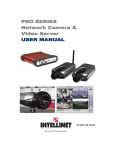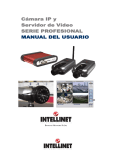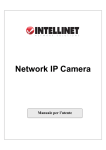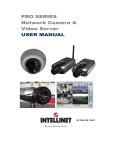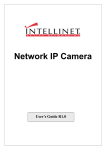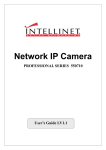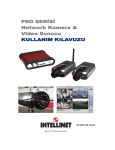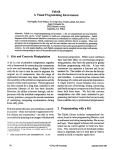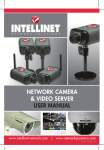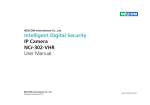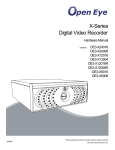Download INT-503181/550178/550253/550796-UM-1106-02
Transcript
(rev. 4-07) INT-503181/550178/550253/550796-UM-1106-02 Table of Contents Safety and Regulatory Notices................................................................................................................................. 3 Section 1: Product Overview .................................................................................................................................... 5 1.1 About the Pro Series (MPEG4) Network Camera ...................................................................................... 5 1.2 Main Features and Benefits.......................................................................................................................... 5 Section 2: Physical Description ............................................................................................................................... 6 2.1 Package Contents.......................................................................................................................................... 6 2.2 Front View and LEDs ..................................................................................................................................... 7 2.3 Rear View ........................................................................................................................................................ 7 Section 3: Installation Summary .............................................................................................................................. 8 Section 4: Assigning an IP Address & Accessing the Camera’s Homepage .................................................... 8 4.1 Assigning an IP Address .............................................................................................................................. 8 4.2 Assigning an IP Address Using IP Installer ............................................................................................... 9 4.2.1 Connecting the Camera to a PC ............................................................................................................ 9 4.2.2 Using IP Installer...................................................................................................................................... 9 4.3 Assigning an IP Address Using HyperTerminal........................................................................................ 10 4.3.1 Configuring HyperTerminal.................................................................................................................... 10 4.3.2 Using HyperTerminal............................................................................................................................... 11 4.4 Accessing the Camera’s Homepage ........................................................................................................... 13 4.4.1 Starting the Web Browser.......................................................................................................................... 13 4.4.2 Login Page ................................................................................................................................................... 13 4.4.3 MPEG4 Network Camera Homepage........................................................................................................ 15 Section 5: Adjusting the Camera Lens.................................................................................................................... 16 5.1 Adjusting the Focus ...................................................................................................................................... 16 5.2 Replacing the Lens ........................................................................................................................................ 16 Section 6: Configuring Administrator Tools .......................................................................................................... 17 6.1 Overview of the Administrator Menu .......................................................................................................... 17 6.2 Image Configuration ...................................................................................................................................... 18 6.3 Network Configuration .................................................................................................................................. 21 6.4 User Configuration ........................................................................................................................................ 23 6.5 Event Trigger Configuration......................................................................................................................... 25 6.6 System Configuration ................................................................................................................................... 28 6.7 Wireless Configuration ................................................................................................................................. 30 6.7.1 Wireless Setup ......................................................................................................................................... 30 6.7.2 Wireless Security Settings ..................................................................................................................... 30 Section 7: PoE Support ............................................................................................................................................. 32 Section 8: Multi-Viewer Application for Windows ................................................................................................. 33 8.1 Installation....................................................................................................................................................... 33 8.2 Usage ............................................................................................................................................................... 34 Section 9: Remote Access to a Camera Installed behind a Router .................................................................... 36 9.1 Preparation ..................................................................................................................................................... 36 9.2 Setup Examples ............................................................................................................................................. 37 Section 10: Developer Information .......................................................................................................................... 38 10.1 CGI Commands ............................................................................................................................................. 38 10.2 Direct Image Access to Internal JPGs ....................................................................................................... 39 10.3 Web Page Integration (ActiveX for Microsoft Internet Explorer) ........................................................... 40 Appendix A: Technical Specifications .................................................................................................................... 42 Appendix B: Frequently Asked Questions (FAQ).................................................................................................. 43 Appendix C: Troubleshooting .................................................................................................................................. 44 Appendix D: Utilizing IP Addresses on a Local Network ..................................................................................... 47 Appendix E: Updating Firmware .............................................................................................................................. 49 Appendix F: The I/O Connector................................................................................................................................ 50 Appendix G: Dynamic Domain Name System (DDNS).......................................................................................... 51 Appendix H: High-Speed Solutions ......................................................................................................................... 56 Appendix I: Reinstating the Factory Default Settings .......................................................................................... 57 Appendix J: Glossary of Terms................................................................................................................................ 58 2 Thank you for purchasing this INTELLINET NETWORK SOLUTIONS™ Pro Series Network Camera, Model 503181 or 550796, or Pro Series Wireless Network Camera, Model 550178 or 550253. This user manual, applicable for software releases 2.0 and later, includes instructions for using and managing the camera on your network. Previous networking experience will be helpful when setting up and using this product, and some knowledge of UNIX or Linux-based systems may also be beneficial for developing shell scripts and applications. Later versions of this document will be posted to www.networkipcamera.com as required. Electromagnetic Compatibility (EMC) This equipment generates radio frequency energy and, if not installed and used in accordance with the instructions, may cause harmful interference to radio communications. However, there is no guarantee that interference will not occur in a particular installation. If this equipment does cause harmful interference to radio or television reception, which can be determined by turning the equipment off and on, the user is encouraged to try to correct the interference by one or more of the following measures: • Re-orient or relocate the receiving antenna. • Increase the separation between the equipment and receiver. • Connect the equipment to an outlet on a different circuit than the receiver. • Consult your dealer or an experienced radio/TV technician for help. • Check that shielded (STP) network cables are being used with this unit to ensure compliance with EMC standards. This equipment has been tested and found to comply with the limits for a Class B computing device pursuant to Subpart B of Part 15 of FCC rules, which are designed to provide reasonable protection against such interference when operated in a commercial environment. Operation of this equipment in a residential area is likely to cause interference, in which case the user, at his own expense, will be required to take whatever measures may be required to correct the interference. This digital equipment fulfills the requirements for radiated emission according to limit B of EN55022/1998, and the requirements for immunity according to EN55024/1998 residential, commercial and light industry. Safety This equipment (Wireless Models 550253 and 550178) complies with EN 60950, Safety of Information Technology equipment. Radio Transmission Regulatory Information This equipment generates and radiates radio frequency energy, and must be installed and operated while maintaining a minimum body-to-camera distance of 3 feet (1 meter). Tested to comply with FCC Standards FOR HOME OR OFFICE USE. This product must be installed and used in strict accordance with the instructions given in the user documentation. This product complies with the following radio frequency and safety standards: Europe — EU Declaration of Conformity. This device complies with the requirements of the R&TTE Directive 1999/5/EC with essential test suites as per standards EN 301489: General EMC requirements for radio equipment; and ETS 300328: Technical requirements for radio equipment. USA — Federal Communications Commission (FCC): This device complies with Part 15 of FCC Rules. Operation of the device is subject to the following two conditions: 1. This device may not cause harmful interference. 2. This device must accept any interference that may cause undesired operation. 3 Video Standard and Product Classification As the video standard varies from country to country, users are asked to check it first and choose the right model. The two most common video standards used are NTSC and PAL. NTSC is the video system or standard used in North America and most of South America. In NTSC, 30 frames are transmitted each second. Each frame is made up of 525 individual scan lines. PAL is the predominant video system or standard mostly used overseas. In PAL, 25 frames are transmitted each second. Each frame is made up of 625 individual scan lines. Below are the four Pro Series Network Cameras represented in this user manual with their appropriate standard. 503181: Wired MPEG4/JPEG Dual Mode Network Camera for NTSC standard 550796: Wired MPEG4/JPEG Dual Mode Network Camera for PAL standard 550253: Wireless and wired MPEG4/JPEG Dual Mode Network Camera for NTSC standard 550178: Wireless and wired MPEG4/JPEG Dual Mode Network Camera for PAL standard To determine your video standard, refer to the lists below. PAL: Afghanistan, Algeria, Argentina (N), Austria, Australia, Bangladesh, Belgium, Brazil (M), China, Denmark, Finland, Germany, Hong Kong, Iceland, India, Indonesia, Iraq, Ireland, Israel, Italy, Jordan, Kenya, Kuwait, Liberia, Malaysia, Netherlands, Nigeria, Norway, New Guinea, Pakistan, Singapore, South Africa, Southwest Africa, Sudan, Sweden, Switzerland, Thailand, Turkey, Uganda, United Kingdom, United Arab Emirates, Yugoslavia, Zambia NTSC: Canada, Chile, Costa Rica, Cuba, Dominican Republic, Ecuador, Japan, Mexico, Nicaragua, Panama, Peru, Philippines, Puerto Rico, South Korea, Taiwan, U.S.A. Important Notices 1. Camera surveillance laws may differ for each country. Contact the local authorities to avoid any surveillance law violations. 2. Note that the CCD lens that comes with the Pro Series Network Camera can be damaged permanently if exposed to direct sunlight. If your application demands prolonged exposure to sunlight, you should consider equipping it with a sun visor. 3. The Pro Series Network Camera is not weatherproof. Be aware of environmental specifications included in the manual. For outdoor use, use a weatherproof case to protect the camera from water, moisture or temperature (higher or lower than specifications). For camera cleaning, gently wipe with a clean, dry cloth. 4. Be sure to use only the DC adapter provided with your camera. Connecting the camera directly to AC current may cause electrical damage to the camera. 5. Be careful when handling the camera. Physical shocks can cause serious damage. 6. Be sure to mount the camera securely to avoid any personal injuries. Keep the camera out of reach of children. 7. If the camera does not operate properly, contact your local distributor. Do not disassemble the product, as that may void the warranty. 4 1 Product Overview 1.1 About the Pro Series (MPEG4) Network Camera Models 503181, 550796 Models 550253, 550178 The Pro Series Network Camera is an all-in-one networking device that contains a digital color camera, a powerful Web server, an optimized embedded operating system, hardware for image compression and a physical Ethernet connection. The camera does not need any additional software or hardware. Simply provide power, connect an Ethernet cable and view from any computer on the network. The INTELLINET NETWORK SOLUTIONS Pro Series Network Camera is ideal for surveillance applications that require high-quality, full-motion video and audio, as well as comparatively low bandwidth demands on the network. This camera provides an easy user interface for remote access to receive the optimal synchronized video and audio from anywhere, anytime over the Internet with the popular Internet Explorer Web browser, as easy as surfing any regular Web sites. More than just a high-performance network camera, the Pro Series Network Camera also offers many advanced features to provide personal or SI solutions, such as remote surveillance, home/business security, audio/video conferencing, motion detection and more. 1.2 Main Features and Benefits Convenient Operation The Pro Series Network Camera does not need any additional software or interaction with any other server. The only software needed is a common Web browser, such as Microsoft Internet Explorer 5.x or above. Open Standards The Pro Series Network Camera supports TCP/IP networking, SMTP email, FTP, HTTP and other Internet-related protocols. The camera can be used in a mixed operating system environment with Windows, Unix, Mac and OS/2. It integrates easily into other www/Intranet applications and CGI scripts. Simple Administration Using a standard Web browser, you can configure and manage the Pro Series Network Camera directly from its own embedded Web pages. The embedded operating system is upgradeable through the network; check with your local INTELLINET NETWORK SOLUTIONS dealer for firmware upgrades. External Devices The auxiliary Input/Output connector on the camera allows you to connect to a variety of external devices, such as IR sensors, switches and alarm relays. Security Your Pro Series Network Camera includes a self-contained Web server, which means that 5 digital images can be secured like any other Internet host. Your network administrator, using the unit’s security settings in combination with an organization’s Internet firewall, normally implements data protection. The administrator can decide whether individuals, groups or the whole world may access the camera. The Pro Series Network Camera supports multi-user password protection. Compression and Performance With a variable frame rate dependent on the image quality and bitrate, the camera delivers MPEG4 video at up to 30 images per second. Dual Mode Compression For application providers, system integrators and other APs, this camera supports JPEG compression as well as MPEG4 video. Full Duplex Two-Way Audio Supported Full duplex two-way audio is available by connecting an external microphone and speaker to the camera. IEEE 802.3af Standard PoE (Power over Ethernet) Supported Software IP Installer for quick installation Multi-Viewer for viewing four cameras 2 Physical Description 2.1 Package Contents Check all items packed inside the box as listed below. ITEM DESCRIPTION REMARKS Network Camera MPEG4 Network Camera Installation CD IP Installer, upgrade program, manual, Multi-Viewer, etc. Program CD Power Supply AC power adapter and power cord AC adapter (110 V – 240 V) and black power cable Stand Wall & table stand* Sturdy iron construction Connection Cable RS-232 cable Black User Manual Hard-copy book * You can use a standard camera stand or tripod for the Pro Series (MPEG4) Network Camera. 6 2.2 Front View and LEDs Power LED (Red): Once power is supplied to the camera, the red LED will light. Network Activity LED Power LED Operating Status LED Operating Status LED (Green): This LED indicates the camera’s operating status. Once power is supplied, the LED lights and then blinks once every second as long as the video is transmitted on the network during normal operation. When there is no video transmission, the LED stops blinking. Under an event-trigger situation, the green LED becomes red and blinks rapidly. During simultaneous operation of event-trigger capture and video monitoring, it blinks rapidly and alternates between red and green. Network Activity LED (Yellow): This LED indicates network activity. When lit, the network is up and running; when off, the network is down and not working. 2.3 Rear View Wireless Antenna (Models 550253, 550178) Zoom/Focus Control/ RS-232 Communication Power Connector Network Connector Mini DIN for External Speaker External Microphone GPIO Connector Power Connector: Only use the supplied AC adapter so as to avoid any possible damage from electric shock. 7 Network Connector: Connect 10Base-T Ethernet or 100Base-TX Fast Ethernet cable. GPIO Connector: To connect external devices such as infrared sensors, alarms or motion detectors (refer to Appendix F: I/O Connector). Mini DIN Connector: To connect external devices such as the external zoom/focus lens mechanism, or to connect directly to a serial port for camera configuration via HyperTerminal. SPK: Use to connect to an external speaker for audio communication. The audio sent over the network from a connected camera client can be delivered through this externally connected speaker. MIC: The external microphone for audio input. The live audio can be captured and transmitted to the connected camera client via the use of this MIC. RESET: Restore the factory default settings. 3 Installation Summary 1. 2. 3. 4. 5. Connect the Ethernet and power to the Pro Series Network Camera. Install and launch the IP Installer program on the enclosed CD. Assign an IP address and network settings Securely mount the camera. Adjust the lens focus. 4 Assigning an IP Address & Accessing the Camera’s Homepage 4.1 Assigning an IP Address To access the camera, you need to assign an appropriate network IP address. Network IP Address: A network IP address is an identification code for computers or devices on a TCP/IP network. Networks using TCP/IP protocols route messages based on the IP address of the destinations within a closed network. IP addresses can be assigned at random as long as each one is unique. However, connecting a private network to the Internet requires using registered, public IP addresses to avoid duplicates. An IP address can be acquired from a network administrator or an Internet service provider. IMPORTANT: Use the newly assigned IP address, and NOT any occupied IP address or the default or example IP address. It is highly recommended that you assign an IP address before placing the camera in a remote location or remote network. MAC (Ethernet) Address (Media Access Control Address): A MAC address is a hardware identification code that uniquely identifies each device of a network. The MAC layer interfaces directly with the network media. Consequently, each type of network media requires a different MAC layer. The MAC address of your Pro Series Network Camera is a 12-digit number. A unique MAC address can be found on the label at the bottom of each camera. Install the IP address installation program (IP Installer.exe) on a PC that is connected to the same local network as the camera. 8 4.2 Assigning an IP address Using IP Installer 4.2.1 Connecting the Camera to a PC 1. Connect with a direct cable (non-crossover UTP cable) when connecting the camera to a switch, hub or router. 2. Connect with a crossover UTP cable when connecting the camera to a PC. 4.2.2 Using IP Installer To install an IP address, you should use the IP Installer provided with the Pro Series Network Camera. You can download its program through the Web site: http://INTELLINET NETWORK SOLUTIONS-network.com. NOTE: The minimum requirement for IP Installer is Windows 9x/NT/2000. 1. Run IP Installer after the camera is done booting (wait until the Operating Status LED blinks every second). 2. Once IP Installer is run, the panel shows every camera connected on the local network. From the cameras listed, select one to assign a new IP address (every Pro Series Network Camera has a factory default IP address). NOTE: The MAC address can be found on the underside label of the camera. To choose a camera, click on its MAC address on the list. 3. Enter the administrator ID and password in the blank (default ID and password are both “admin”) to assign or change the IP address for the camera and setup. 4. Enter the IP address, gateway address, subnet mask address, DNS server address and server IP address assigned by the network administrator. (When the addresses are not assigned properly, you cannot access the camera.) The server IP address represents an IP address of a PC being used to execute the upgrade program when updating the camera (refer to Appendix E: Updating Firmware). 5. After entering all addresses for the camera, click on “Change Network Configurations.” The message shows up if all the information is set up properly. Then click the “OK” button. NOTE: After changing the network configuration, it may take a little time to reboot the camera in order to access the camera’s homepage. 9 4.3 Assigning an IP Address Using HyperTerminal NOTE: This section is for advanced users only. This procedure is not normally required. 4.3.1 Configuring HyperTerminal HyperTerminal is a basic program for Windows 9x/NT/2000. A PC can communicate with external devices through the serial port by using this program. The steps you should take to set the HyperTerminal are as follows with a Windows 2000 OS: 1. Go to Start Programs Accessories Communications HyperTerminal. Select one of the icons and then enter an appropriate name in the box. 2. Select a serial port of the PC, then click “OK.” (Usually COM1 or COM2 is recommended.) 3. Configure bit/sec as 115200 and leave other settings at the default values. 10 4. The window should display as below when configured properly. (If it doesn’t, try again from the beginning.) 4.3.2 Using HyperTerminal Follow these steps to assign an IP address using HyperTerminal. 1. Run HyperTerminal on your PC. 2. Connect the RS-232 cable from the serial port of the PC (selected in section 4.3.1: Configuring Hyper Terminal) to the camera serial port while HyperTerminal is active. 3. Turn the camera on. 4. A countdown will start with the message “Press any key to stop auto-boot.” 5. Press any key to display the “Boot” screen as shown below. 11 NOTE: You can view the network configuration while the boot window is on screen by entering “ps” again. Here, the IP address, netmask, gateway, TFTP server and MAC address (Ethernet address) values are network configuration values. You should change these values in most cases. If you don’t know what value you should assign, refer to the network administrator. IP Address and subnet mask addresses are separated by colon (:). For example, the IP address is represented by decimal numbers delimited by a dot (.) like “192.168.1.27.” Hexadecimal numbers like “ffffff00” (in the case of 255.255.255.0) represent a subnet mask address. Note that the numbers of the subnet mask value are not delimited by a dot. Gateway (g) is the gateway address of the camera. TFTP Server IP is the address to which the camera tries to connect to upgrade its firmware program in flash memory. The camera first searches this host on the network during the booting sequence. For information on any Pro Series Network Camera upgrade, refer to Appendix E. MAC Address is the Ethernet address of Network Camera. 12 NOTE: Enter “cs” to change the network configuration during the boot prompt. If you enter “cs,” the camera shows you the information for which you can change values and the current assigned values. You can make changes as shown below. When you terminate the HyperTerminal program after you have changed the network configuration, it asks if you wish to save the session. If you save the session, you can re-use HyperTerminal. To re-use the session you saved, click Start Programs Accessories Communications HyperTerminal MPEG4 Network Camera.ht (with Windows XP/2000). 4.4 Accessing the Camera’s Homepage After assigning an IP address, you can access the camera and monitor real-time images over the Internet. You can configure the camera within its own pages through any standard Web browser on a local or remote network. 4.4.1 Starting the Web Browser Start your Web browser, entering your camera’s IP address on the address bar in order to access the login page. The default IP address is 192.168.1.221. 4.4.2 Login Page Select a viewing program Users of Windows/MS Internet Explorer should select ActiveX. All other users should select Java Applet. 13 Username and Password Enter a username and password to access the camera. The camera has two default user accounts. • Administrator account: To view the live image and change the camera settings. Username: admin Password: admin • Guest account: To view the live image, but not access any camera settings. Username: guest Password: guest Behind a Firewall If your PC is connected to a network with a firewall, you may not view real-time video properly because the video TCP port is blocked. Whenever you can see the login page in your Web browser but no live video shows up on the main camera live screen, you should activate this option. ActiveX for MS Explorer Users For all Microsoft Explorer users, the ActiveX Control program is required. The program will be installed automatically when a user accesses the camera. For ActiveX installation on your PC, just click “Yes” to the question “do you want to install the program?” on the pop-up window. If you cannot see images after installation, you should download and install ActiveX manually. The link is provided on the login page of the camera. Manual Installation of ActiveX If the ActiveX program fails to install automatically, you can install it manually. 1. When the first window displays, click “Open” to install the program. 2. After the download, the InstallShield Wizard window displays. Check “Repair” and click “Next.” 3. When ActiveX installation is complete, click “Finish” and return to the login page to access the camera’s homepage. Java Applet for Macintosh or Unix System Users Java Applet is designed for all operating systems and virtually all Web browsers, including Mac OS and Linux-based systems, and Web browsers like Firefox, Mozilla, Opera and many more. NOTE: The camera’s ActiveX program is based on an MS Windows OS. Therefore, it is impossible to access the camera and monitor real-time images through a default viewer. If a user accesses the camera through Macintosh or Unix systems, the camera detects that the OS is not MS Windows and it operates a Java-based image viewer to show real-time images. Some functions are not available for Java Applet. It is highly recommended that Internet Explorer 4.0 or higher is selected for the ActiveX viewer for Windows 95/98/2000/NT. Otherwise, selected the Java Applet viewer. 14 4.4.3 MPEG4 Network Camera Homepage Once the login procedure is complete, you can view the Pro Series (MPEG4) Network Camera homepage. Video Size You can select a viewing image size from 0.5 to 2. This function may be used when you want to expand the image size on your PC. (Resolution can’t be changed at all.) Audio Select audio “On” for starting audio communication; select “Off” to stop audio communication over the network with the external microphone and speaker connected to the camera. Administrator Menu This button is for accessing the administration menu. However, only the user who has authority as an administrator can access the page with administrator’s ID and password (see Configuring Administration Menu). Logout User can go back to the Login page by using the “Logout” button. Save Snapshot To save only one image, press the “snapshot” button and then select a folder. The image is saved as a JPEG file (with the default file name composed of the date and time: image_yyyy_mm_dd_hh_mm_ss.jpg). Record Video Users can save real-time images from the camera on a PC. Click “Start,” then select the folder to save the images in. (The image is 15 saved as an AVI file.) Once the camera starts to save images, the green LED indicator will start blinking. To stop saving, click “Stop” and the LED indicator will stop blinking. Camera Name & Location Through the system configuration menu, you can set a camera name and location (see section 6.6: System Configuration). NOTE: You can view a saved image with Windows Media Player or RealTime. For the initial playback of a saved image, click “Install XviD.” The AVI save will be split every 20 minutes (for example: file name 2002_04_22_15_00, file name 2002_04_22_15_20…). 5 Adjusting the Camera Lens 5.1 Adjusting the Focus To get the finest image, adjust the lens focus according to your environment. To make this adjustment, simply turn the lens in either direction till you get the most well-defined image edges while viewing the picture quality on your Web browser. Turn this part either clockwise or counterclockwise to adjust the lens focus. Turn this part counterclockwise (with the lens facing you) to unscrew the lens for replacement. NOTE: Do not force the lens beyond either the clockwise or counterclockwise limit. Also, a good level of focus is normally achievable throughout several planes within the camera’s focusing spectrum. Since optimum focusing is dependent upon the camera’s field of view, it is important to scan the focusing plane from the closest to furthest perspectives before attempting any fine-tuning. 5.2 Replacing the Lens The Pro Series Network Camera is designed with a CS mount. The lens supplied with your product can be replaced with any standard C or CS lens, typically used within the surveillance industry. Follow the instructions below to replace the supplied lens with any C or CS type lens. 1. Unscrew the camera lens by turning the lens counterclockwise (see above). 2. For C lens only: Attach the new lens to a C-CS adapter. 3. Screw the new lens onto the camera. If applicable, adjust the iris according to the prevailing light conditions. 4. Focus the lens as instructed above. 5. Reload your Web browser and monitor the results from the product home page. 16 6 Configuring Administrator Tools You can control the configurations of the camera using the administrator tools, which can be accessed only by an authorized user. If non-authorized users try gaining access, you may see the caution message “You are not an administrator.” 6.1 Overview of the Administration Menu The table below provides a one-step overview of the Administrator Tools: Image Configuration To Configure compression rate, image size, brightness, contrast, etc. Network Configuration To configure camera IP, Web server port, image transfer port Admin, User Configuration To configure user ID and password System Configuration TO CONFIGURE THE CAMERA NAME, LOCATION AND TIME SETTINGS Event Trigger Configuration To configure trigger condition, image capture option, trigger output, etc. Wireless Configuration (wireless models only) To configure wireless parameters such as wireless mode, SSID, encryption, etc. Return to Live View To go back to the monitoring page 17 To prevent any unauthorized use of the camera, access is strictly restricted to defined users. Administrator(s) has exclusive access to the administrator tools, and can determine the registration and access rights for all users. Enter your ID and password, then click “Submit” (default ID and password are all “admin”). NOTE: Although the administrator’s default username and password (set to “admin” for all) can be used for logging in to the unit for the first time, it is highly recommended that you change this password for your camera as soon as possible since all Pro Series Network Camera products are shipped with the same ID and password as defaults. Also, make sure to click “Submit” after verifying any reset configuration; otherwise, it won’t be changed. 6.2 Image Configuration Rate Control Select the rate control by selecting the VBR (variable bitrate) or CBR (constant bitrate) control. In VBR mode, the picture quality is fixed with fixed quantization value and the bitrate varies automatically in reaction to the complexity of the video to maintain the set quality, thus using more bandwidth for complex video and less bandwidth for lower-activity video. VBR is appropriate for storage applications, and can be used where video needs to be streamed over a fixed-bandwidth link. In CBR mode, the bitrate is fixed irrespective of image complexity, and the picture quality is automatically adjusted by the MPEG4 encoder on a frame-by-frame basis to maintain the preset average bitrate. Thus, the network bandwidth consumption is always fixed and predictable. CBR is of particular benefit where video needs to be streamed over a fixed-bandwidth link. 18 Quality Set the quality of encoding images. The lower the number, the higher the quality. This option is available when selecting the VBR rate control. Note that to achieve the set quality, the maximum bitrate can be used in VBR mode. Thus, the higher the set quality is, the more bandwidth usage on the network. Bitrate Set the target bitrate of the encoding video. This option is available in CBR mode only. You can set the bitrate values from 30 kbps up to 9000 kbps at an interval of 300 kbps. A higher bitrate ensures higher quality of the live video at the expense of more network bandwidth usage. Controlling the maximum bitrate is good for controlling the bandwidth used by the MPEG4 video stream. As the bitrate is fixed, the frame rate and image quality can be affected adversely. That is, the frame rate and image quality are reduced when the bitrate is fixed. Resolution Select the resolution for output video. Pro Series Network Cameras support three types of image resolution. NTSC: D1 (720x480) VGA (640X480) and CIF (352x240); PAL: D1 (720x576) VGA (640X576) and CIF (352x288). Frame Rate Select the frame rate according to your preference. The higher value of frame rate ensures smoother video; but the higher the frame rate, the larger the network bandwidth. GOP Set the size of GOP (group of pictures). MPEG4 video stream consists of continuous GOP, and one GOP consists of one “I” frame plus “P” frames. This value equals the period of one “I” frame. The more the GOP size, the less network bandwidth will be occupied. Setting a high value of GOP will save considerable network bandwidth, but at the expense of image quality. Display Name/Location Stamp Select “On” to display the camera name and location at the top of the transmitted images. Display Time/Date Stamp Select “On” to display the camera time and date at the top of the transmitted images. Vertical Flip and Horizontal Flip These options let you flip the live video in your web browser horizontally and vertically. This option does not have any effect on video which is transmitted by the camera via FTP or E-Mail. De-Interlace Select this filter to monitor a de-interlaced video (a sequence of frames). The camera generates, by default, interlaced video (a sequence of fields) which produces horizontal lines on the screen for moving objects. Users are recommended to select “de-interlace enabled” in case their camera watches over moving objects. In interlaced video, horizontal lines appear when there are fast-moving objects (as below). 19 De-interlaced video gets rid of these lines from your screen. (See de-interlaced video below.) Brightness Set the image brightness. A higher number equates to brighter video (input 0 to 255). Contrast Set the image contrast. A higher number equates to a brighter image (input 0 to 200). Hue Set the color temperature of the video. Normally there is no need to change the default value. Saturation Set the saturation value of images. Higher saturation values generate deeper colors (input digits 0 to 255). Color Killer Enabling this will switch the image into gray (monochrome) format. Disabling this option sets the images at their original color. Submit Transfer a current configuration data to the camera. Cancel Cancel the entire configuration you made. Load Default Values Set the image configuration as default values. (No need to click “Submit.”) 20 6.3 Network Configuration This screen defines the network type and addresses of the camera. Here you can configure the camera’s IP address, the DNS server address and the SMTP server IP address. Set IP Address, Subnet Mask, Gateway Address To set the IP address, subnet mask and gateway address manually, select “manually” in the combo box. (These manual settings can also be made with the IP Installer.) If you have any trouble in configuring network system information, contact your network administrator. 21 Set DHCP When selecting “using DHCP,” the IP address, subnet mask address and gateway address are being obtained from a DHCP server. Users in a local network area may check the IP address through IP Installer. NOTE: If you select “DHCP,” you may see the rebooting message “Now the Network Camera is rebooting to apply the changes...” on the Web browser. After completion of the reboot, the Status LED blinks once per second. (Confirm that the Operating Status LED blinks after selecting “DHCP” and the rebooting process to ensure your new setting took effect.) To select DHCP, you must have a DHCP server in the network. Otherwise, the IP address will be rebooted automatically as the previous IP address. It can take about 4 minutes for booting. After rebooting, re-enter the previous IP address. You may see the fail message from the “Network Configuration” page. Send an IP Address to Email To send camera system information (camera name, camera location, DHCP IP address), click in a text box and enter your email address. (You should configure your SMTP server information first.) Web Server Port Number To set the port number for the Web server. (The default port number is “80”; users can select from 80 to 1023.) Image Transfer Port Number To set the port number for the video/image transfer. (The default port number is “40001”; users can select from 8000 to 65535.) Audio Send Port Number To set the port number for the audio transfer to the connected camera client. (The default port number is “40008” and users can select from 8000 to 65535) Audio Receive Port Number Set the port number for the receiving audio from a connected camera client. (The default port number is “40007”; users can select from 8000 to 65535.) Upgrade Port Number To set the port number for upgrading firmware. (The default port number is “9000”; users can select from 8000 to 65535. PTZ Port Number NOTE: PTZ control is not available on these Pro Series Network Camera models. ETSP Port Number To set the port number for ETSP (Event Trigger Setting Program). (The default is “11000”; users can select from 8000 to 65535.) (For details about ETSP, refer to the ETSP manual.) 1st, 2nd DNS Server Address To map between an IP address and domain name, you should enter your DNS server address. If a user sets the DNS server into the camera, users can configure the SMTP server, FTP server and NTP server with its domain name. NOTE: A DNS (domain name system) is for mapping between an IP address and domain name. Every network device in the world has its IP address for connecting to the Internet. And the device is to be connected not with its domain name but with its IP address. Ordinary users may not be familiar with IP addresses, but know the domain names. If a user accesses a certain network device with its domain name, the DNS server translates the domain name into an IP address of the device and replies to the user with the result. SMTP Server Enter the SMTP server IP address or hostname here to send camera system information by email. You should configure this first to get camera system information by email. 22 Use SMTP Authentication If you need user authentication for using the SMTP server, check in a box and enter your ID, password and realm for your SMTP server. (The camera’s SMTP authentication is supporting the “LOGIN” method.) • Authentication method: Choose the SMTP authentication method. • ID: Enter the user ID for SMTP authentication. • Password: Enter the user password for SMTP authentication. • Realm: Enter the realm for SMTP authentication. DDNS Registration To register the camera to the DDNS (dynamic domain name system) server, check in an “enable” box. A dynamic IP address complicates remote access since you may not know what your current WAN IP address is when you want to access your network over the Internet. The solution to the dynamic IP address problem comes in the form of a dynamic DNS server. ID, Password Enter the ID and password to find the registered camera on the DDNS server. Hostname Enter the hostname to find the registered camera on the DDNS server. DDNS Manual Update You can update the DDNS server manually. CAUTION: Repeated use of the function may lead to the blocking of your DDNS domain name. Status To show the status of successful access to the DDNS server. Submit Send configured data by user to the camera. 6.4 User Configuration This screen is used to configure IDs and passwords for an administrator and up to five users. User Account There is one administrator account and five user accounts. Account names can be changed. Password If you want to open your Pro Series Network Camera to everyone, you may not change default users’ ID and password. However, you should change administrator’s ID and password with unique ones of your own. 23 Maximum Frame Rate The user can decide the maximum frame rate per second. Access Rights The administrator may assign users’ rights of viewing control. With the default setting, the administrator has complete authority of configuration, and the normal user doesn’t have any right except for accessing the login page to see the live image. The default ID and password are both “guest.” NOTE: The size limit for any ID or password is 10 bytes, which is equal to 10 alphanumeric characters/digits. 24 6.5 Event Trigger Configuration This screen is used to receive captured video through email or an FTP. You may also connect external devices, such as an infrared sensor or alarm sensor, to use with the provided terminal block (refer to Appendix F: The I/O Connector). Trigger Condition This is to select options for sending an event signal to the camera. • Activation of digital input port from…: The camera receives an event signal from external devices such as an infrared sensor, alarm sensor, etc. 25 • Motion Detection from…: This is to detect motion from the camera by S/W data comparison. When you select “Motion Detection,” the camera detects a motion triggered by the camera. To detect motion, the camera compares a previous image to the present image. When the camera recognizes the data change by comparing the previous image data with the present one, then motion detection function is activated. NOTE: In a dark location, the camera may not detect motion when it “sees” no difference between two compared images. • Periodically...: The camera itself is triggered periodically by setting a certain value from 1 to 3600 seconds. You may set the periodical event time for a certain hour — like 06:00 to 24:00 — by setting 1 o’clock to 24 o’clock. • Motion Detection Sensitivity: This is to configure the level of motion detection sensitivity. The level is composed of five levels, from 0 to 4. The higher the level, the more sensitivity applies. NOTE: At level 4, even the slightest motion may be detected (including light changes). The sensitivity at level 0 (zero), on the other hand, may not be sufficient. It is strongly recommended that the motion detection sensitivity be set at level 1, 2 or 3 for normal conditions. • Motion Detection Area: This is to configure the motion detection area in the images. Up (Upper) Middle Down (Lower) Left Right Middle (Center) Whole (Full) CAUTION: It is not recommended that the motion detection function be used for security purposes, as it is designed only for monitoring. To use the camera for security purposes, it is suggested that infrared, motion or other sensor(s) be added. Image Capture Option This is to configure image capture options when an event is triggered. When an event occurs, you can get the pre-event and post-event images by setting “Before event” and “After event.” • Before event: You may set the starting time to capture an image before the event is triggered. (Input limitation is from 0 to 30 seconds.) • After event: You may set the finishing time to capture an image after the event is triggered. (Input limitation is from 0 to 30 seconds.) • Image capture frame rate: Set from 1 to 15 fps when an image is being captured. • Image file name: You may designate the image file name to send email or FPT after an image is captured. All captured images are saved as .avi files. (example: Filename.avi) • Append to the image file name: You may add information to the image file name. - Camera IP address (example: filename_192.168.1.19.avi) - Date and time (example: filename_20020218150030.avi) - Trigger condition flag: When selecting “Activation of digital input port,” “D” may be added to the image file name (example: filename_D.avi); when selecting “Periodically every…,” “P” is added to image file name (example: filename_P.avi). - Image sequence number: With this option, you may classify a file with the same name with consecutive numbers from 000 to 999 (example: When you designate file name as “camera” and select “Image sequence number,” the file name appears as camera001.avi,” “camera002.avi” and so on through “camera999.avi”). Image Capture option limitation The configuration for the image capture option affects memory capacity. If the configuration uses excessive memory, the warning message “Not enough memory…” will display. The total image capture frame rate must be no more than 120 fps due to memory size. (Before event time + After event time) x (Image capture frame rate) must be under 120. For example, if “Before event time” is 3 seconds, “After event time” is 2 seconds and “Image capture frame” is 3 fps, the total image capture frame rate is (3 + 2) x 3 = 15 fps. If a warning message appears, reduce the value of the option. 26 Trigger Output This is to configure digital output states and control script. The Pro Series Network Camera sends captured images via email or an FTP server when connected external sensors detect events. • External devices signal output: This is to supply voltage to the output port when events are triggered. (This option is only activated when you select the “Activation of digital output” option in the “Trigger Condition” section.) • Send alarm to ETSP client: By checking the box, an alarm will be sent to the ETSP client when the events are triggered. • Send captured image to email: This is to designate a person to receive captured images via email through the SMTP server. You may configure the SMTP server and email address as desired. • Send captured image to FTP server: This is to send captured video from the camera when an event is triggered. Enter an FTP server IP address, user ID and password, and select a directory to save video. 27 6.6 System Configuration This screen is used to configure camera name, location, operation mode and system information, as well as time configuration for the camera. Camera Name Configure the camera name for the front-page view (maximum of 10 characters). Camera Location Configure the camera location for the front-page view (maximum of 10 characters). Operation Mode There are two operation modes for the camera: dual mode and single mode. In dual mode, the camera can encode and transmit both MPEG4 and JPEG images simultaneously over the network. In single mode, only MPEG4 video will be encoded and transmitted. JPEG images transmitted in dual mode are accessed through http://camera IP (URL)/jpg/imagename.jpg. In dual mode, audio communication from PC to camera is not available, whereas in single mode (which uses MPEG4 only) bi-directional audio communication is available. 28 Image File Name This option is used to for accessing the JPEG images with “.jpg” extensions. The file name should be less than or equal to 10 characters. Supply Voltage to Output Port Option This option is for supplying voltage to the camera’s output port. Camera On/Off This option is used to stop sending video and audio temporarily from your camera over the Internet or network. When "off" is selected, the camera displays the message " Video/Audio is disabled by Admin" on the live video page. System Information This is to check system information for the camera. You may see the model name, serial number, Mac number, and Bootrom and Firmware version (see Appendix E: Updating Firmware). Synchronized with NTP Server The camera automatically configures the date and time through the NTP (network time protocol) server. The NTP server is based on Greenwich time. Select the NTP server, IP address and time zone to set the date and time automatically, then click “submit.” NOTE: If this procedure doesn’t work, it could be due to a network error. Select another NTP server and IP address or set the date and time manually. Once the date and time configuration is set, you don’t have to configure it again. • NTP Server: The standard public or private NTP server IP address. • Time Zone: Select the appropriate time zone as per the camera location. • Update Interval: The update time interval for updating/synchronizing the camera time with the NTP server. Set Manually Enter the date and time manually, then click “submit.” Enable Daylight Savings Enter the dates you want to start/end Daylight Savings Time. NOTE: The camera does not support RTC (real-time clock) in the “Set Manually” option, and will default to 2001/01/01 00:00:00. Reboot (Restart) Network Camera This option will reboot or restart the camera. Your settings will not be lost. Restore Factory Default Values This option will restore the default factory values. 29 6.7 Wireless Configuration (for wireless MPEG4 camera only) This screen is used to configure wireless settings to match your access point for a wireless network connection. 6.7.1 Wireless Setup 1. Use the operation mode to determine the type of wireless communication for the Pro Series Wireless Network Camera (models 550178 and 550253): Infrastructure or Ad hoc. The default setting is Infrastructure. 2. Set the service area name (SSID) as per the access point setting to which the user wants to connect. 3. The channel is set to a default. In Infrastructure mode, the camera will automatically find the access point. The channel only needs to be set in Ad-hoc mode. 4. The default setting for the “Tx rate” is Auto; however, it can be set up to 54 Mbps in 802.11g mode and up to 11 Mbps in 802.11b mode. 5. The preamble mode should be set to Auto, but in some cases you may want to set it to either long or short, depending on your setup. 6. The camera supports three different wireless modes: • 11b/g Mixed (camera connects to any 11 or 54 Mbps wireless access point) • 11b only (camera connects only to 11 Mbps wireless access points) • 11g only (camera connects only to 54 Mbps wireless access points) 6.7.2 Wireless Security Settings WEP Wireless network communications are easily intercepted. WEP (wired equivalent privacy) is an encryption method specified by the IEEE 802.11b standard to make any intercepted communications extremely difficult to interpret by unauthorized parties. The WEP key needs to be entered in HEX code. To set up 64-bit WEP, input 10 HEX characters; for example, 0123456789. To set up 128-bit WEP, input 26 HEX characters; for example, 01234567890123456789012345. Authentication: WEP uses two types of authentication methods to authenticate the connection request. One is OPEN key authentication, in which all clients are allowed to authenticate; the 30 second is SHARED key authentication, which allows the AP (access point) to send the client a challenge text, which the client encrypts and returns to the AP. If the AP successfully decrypts the challenge text, the client is authenticated. Set the authentication type as per the access point authentication type. The wireless camera’s Auto mode automatically switches between open and shared modes. Example 1: Suppose your access point uses 64-bit encryption, the default key is 1, authentication is shared and the key value is 0123456789. Your wireless camera WEP setting will be: Example 2: Your AP uses 128-bit encryption, the default key 2, authentication is shared and the key value is 01234567890123456789012345. Your wireless camera WEP setting will be: NOTE: All four WEP keys need to be set up the exactly same way they are defined in your wireless access point. Make sure the encryption code is the same as that of the access point the camera will be connected to under Infrastructure Mode. Your PC’s encryption code also needs to be set up to match the camera’s encryption code under either Infrastructure or Ad hoc mode. The default setting for the encryption key is Disable; therefore, to secure the wireless transmission, be sure to enable the encryption key by entering the relevant data. NOTE: Carefully enter encryption codes, as any error will cause the communication link to fail. IMPORTANT Infrastructure Mode This is an 802.11 networking framework in which devices communicate with each other by first going through an access point (AP). In Infrastructure mode, wireless devices can communicate with each other or can communicate with a wired network. When one AP is connected to a wired network and a set of wireless stations, it is referred to as a basic service set (BSS). An extended service set (ESS) is a set of two or more BSSs that form a single subnetwork. Most 31 corporate wireless LANs operate in Infrastructure mode because they require access to the wired LAN in order to use services such as file servers or printers. Ad hoc Mode This is an 802.11 networking framework in which devices or stations communicate directly with each other, without the use of an AP. Ad hoc mode is also referred to as Peer-to-Peer mode, or an independent basic service set (IBSS). Ad hoc mode is useful for establishing a network in which a wireless infrastructure does not exist or in which services are not required. SSID (service set identifier) This is a 32-character unique identifier attached to the header of packets sent over a WLAN that acts as a password when a mobile device tries to connect to the BSS. The SSID differentiates one WLAN from another, so all access points and all devices attempting to connect to a specific WLAN must use the same SSID. A device will not be permitted to join the BSS unless it can provide the unique SSID. An SSID is also referred to as a network name because, essentially, it is a name that identifies a wireless network. To connect a wireless client such as a Wireless Pro Series Network Camera to a specific AP, the user of the camera should specify the SSID name in the camera’s wireless IP setting. 7 PoE (Power over Ethernet) Support Power over Ethernet use a single Ethernet cable to transmit both power and data. For PoE to work, the electrical current must go into the data cable at the power-supply end and come out at the device end in such a way (as shown below) that the current is kept separate from the data signal so that neither interferes with the other. The current enters the cable by means of a component called an injector. The Pro Series Network Camera models are IEEE 802.3af standard PoE compliant. They can be used with any IEEE 802.3af-compliant PoE injector. Compatible INTELLINET NETWORK SOLUTIONS PoE Products: PoE Web-Smart Switch, model 502917. 8-Port Desktop, IEEE 802.3af compliant, Endspan PoE Midspan, model 502931. 8-Port rackmount, IEEE 802.3af compliant 32 8 Multi-Viewer Application for Windows With Multi-Viewer for Windows, it is possible to view up to four different network cameras on one PC monitor. It is small, fast, handy and very easy to install and to use! Multi-Viewer supports the following INTELLINET NETWORK SOLUTIONS cameras: - MPEG4 CCD Network Cameras (503181, 550796, 550178 & 550253) - JPEG CMOS Network Cameras (550710, 550703 & 550734) - Network Video Server (550000) 8.1 Installation Insert the supplied CD into the CD-Rom drive of your computer and open the Multi-Viewer folder. Find “Multiviewer.exe” and double-click it to start the installation. Click “Next.” Click “Browse” to select the installation folder; click “Install” to begin the installation. 33 Wait for the installation to finish. 8.2 Usage After the successful installation, you can start Multi-Viewer by clicking on Start, then Programs, then INTELLINET, then Multi-Viewer. Multi-Viewer opens, and the following screen appears: Configuration Page Refresh/Reconnect Disconnect Quit Multi-Viewer Show/Hide Camera Information Log Messages In order to add a camera, simply double-click the location on the screen (upper left, lower left, upper right or lower right square). Enter the correct settings in the configuration window and click “OK.” Make sure that all values are the same as those in administrator’s menu of the camera. The image below shows the correct settings for a camera running at factory default values. You may need to make changes for your camera. 34 IP Address Check here if you use dynamic DNS, then enter your DynDns domain name into the configuration. Check here if your computer or the camera is behind a firewall. Specify the image transfer port of your camera (select MPEG4 unless you have changed the camera settings). Username and password (regular user account suffices). Select MPEG4 or JPG – depending on your camera model. Additional image parameters. Enter the maximum frame rate you with to receive from the camera. Repeat the steps for each camera. (See the sample screens below.) 35 9 Remote Access to a Camera Installed behind a Router In order to gain access to a camera in your local network over the Internet, certain ports need to be opened and forwarded in your router. The camera uses the following ports by default: - Web Server port = 80 (TCP) - Image Transfer port = 40001 (TCP) - Audio Send port = 40008 (TCP) - Audio Receive port = 40007 (TCP) - Upgrade port = 9000 (TCP) In order to view the live image over the Internet, the Web server and image transfer ports need to be opened and forwarded in the router. In order to receive and send sound, the audio send and receive ports must also be added to the router configuration. 9.1 Preparation Before you can add the information in the router, you need to find out which local IP address your camera has and which ports it uses. You can do that by connecting to the camera's Web administrator menu (network configuration screen). MPEG4 Network Camera default values are shown below. Note: IP Address of camera Web-, Imageand AudioPorts of camera 36 9.2 Setup Examples 9.2.1 INTELLINET NETWORK SOLUTIONS MIMO Wireless Turbo G Router (Model 502207) Go to NAT Virtual Server. Check (x) Enable Virtual Server. Enter the camera IP address, along with the Web server (private and public ports should be identical), select “TCP” for type and enter a description in the comments field. Click “Add.” Repeat the step for the other ports. The end result should look like this: Click “Apply” to save the settings. 37 9.2.2 INTELLINET NETWORK SOLUTIONS Wireless Super G Router (Model 502566) Go to Access Virtual Server. Check (x) Enable Virtual Server. Enter a descriptive name, enter the public and private ports, select “TCP” as the protocol and enter the IP address of the camera in the LAN Server field. Click “add.” The result should look like this: 10 Developer Information 10.1 CGI Commands INTELLINET NETWORK SOLUTIONS MPEG4 Network Cameras support HTTP CGI calls to perform certain functions or to remotely program the camera. As a developer, you have access to virtually every parameter the camera has to offer: You can query the alert state of the 38 camera and trigger the digital IO port, and you can change image settings and network parameters remotely. Example: Change image resolution to D1 (high resolution) http://camera_ip/image_set.cgi?id=admin&passwd=admin&Resolution=d1 Example: Change image resolution to CIF (low resolution) http://camera_ip/image_set.cgi?id=admin&passwd=admin&Resolution=cif Example: Enable Color Killer http://camera_ip/image_set.cgi?id=admin&passwd=admin&Colorkiller=on Example: Enable Motion Detection http://camera_ip/event_set.cgi?id=admin&passwd=admin&Motion_Option=on Example: Disable Motion Detection http://camera_ip/event_set.cgi?id=admin&passwd=admin&Motion_Option=off Example: Set Camera Name http://camera_ip/system_set.cgi?id=admin&passwd=admin&Cam_Name=value Example: Set Wireless ESSID http://camera_ip/wireless_set.cgi?id=admin&passwd=admin&Ssid=value Example: Set Camera IP Address http://camera_ip/network_set.cgi?id=admin&passwd=admin&Ip=111.222.333.444 Example: Query Network Settings of camera http://camera_ip/inquiry.cgi?id=admin&passwd=admin&inq=network This command returns an HTML page containing the entire network configuration. A programmer can parse through the results to get a certain value; e.g., the IP address. Complete CGI command documentation is available at http://www.networkipcamera.com. 10.2 Direct Image Access to Internal JPGs The camera supports a Dual mode of JPG and MPEG4 video. Dual mode can be activated on the System Configuration page in the Administrator Menu subsection. If Dual mode is enabled, you have access to the still image (JPG) by using the URL http://camera_ip/jpg/image.jpg. The "image.jpg” section can be adjusted for security reasons; 39 most network cameras only offer a fixed URL. Enter the URL in your Web browser. After you enter the username and password, you can see the live (still) image. Refresh the view to see the most current image. 10.3 Web Page Integration (ActiveX for Microsoft Internet Explorer) The live video can be integrated into any Web page without forcing the user to login or show the INTELLINET NETWORK SOLUTIONS branded user interface. Embedded live video via ActiveX (for MSIE / Windows) 40 <object id='M4ActiveX' width=720 height=576 classid='CLSID:D325B21F-D2134824-854B-512F7A0F1478' codebase="./M4VActiveX.cab#version=1,0,2,4"> <PARAM NAME="VStreamPort" value="40001"> <PARAM NAME="AStreamPort" value="40008"> <PARAM NAME="OStreamPort" value="40007"> <PARAM NAME="UserID" value="guest"> <PARAM NAME="UserPW" value="guest"> <PARAM NAME="MaxFrame" value="30"> <PARAM NAME="UserFrame" value="30"> <PARAM NAME="Gop" value="1"> <PARAM NAME="HKey" value="0"> <PARAM NAME="ImageWidth" value="720"> <PARAM NAME="ImageHeight" value="576"> <PARAM NAME="IsBehindFirewall" value="0"> <PARAM NAME="Deinterlace" value="0"> <PARAM NAME="OSDDisplay" value="1"> </object> <script language="JavaScript"> document.M4ActiveX.CameraIP="111.222.333.444"; </script> The BOLD parameters have to be adjusted to fit your camera. width & height: Adjust the size of the image. Possible values are: (PAL): 720 x 576, 640x576, 352 x 288; (NTSC): 720 x 480, 640x480, 320 x 240 VStreamPort, OStreamPort, AStreamPort: Camera Ports The code shows the default values. If you have changed any of these settings in your camera, you need to make adjustments here. UserID, UserPW: A valid user account for the camera. Do not use the Adminstrator account in the source code for security reasons. Use a regular user account (e.g., the guest account) instead. UserFrame: To limit the bandwidth the camera uses, you can reduce the value here. "30" refers to the maximum frame rate of 30 fps. If you change that value to "2," then each visitor to your Web page would only receive a maximum of 2 fps. Value "0.5" means: 1 frame every other second Value "0.2" means: 1 frame every 5 seconds Value "0.1" means: 1 frame every 10 seconds (example above) IsBehindFirewall: This option needs to be set to "1" if you have not entered the VSTREAM port of the camera in your router's port forwarding table, but only the Web server port (default = 80). If you have set up both ports in the port forwarding table of the router, the default value "0" should be used. Deinterlace: The deinterlace option helps to improve the image quality. It reduces the effects of interlacing. [0] = deinterlacing off [1] = deinterlacing on CameraIP: Enter the public IP address of the camera, the domain name or the DDNS name for your camera. Visit http://www.networkipcamera for additional information; e.g., implementation via JAVA Applet. 41 Appendix A: Technical Specifications Specifications Items Model 503181 / 550796 Model 550253 / 550178 Image Sensor 1/3" Sony Super HAD CCD 1/3" Sony Super HAD CCD Network Connection Wired Wired/Wireless Compression Standard MPEG4 / JPEG (Supports Dual Mode) Video Resolution NTSC : 720x480, 352x240 (default) PAL :720x576, 352x288 (default) Minimum Illumination 0.1 Lux at f=1.8 Buttered Image About 200 frames (320x240) at max. with time display Audio Communication 2-way Full Duplex Audio Bandwidth 300 Hz – 3.4 kHz Audio Input External Microphone Input Terminal Audio Output Audio Line Output Terminal for External Speaker Maximum User Support 50 users Protocols TCP/IP, UDP, HTTP, FTP, SMTP, DHCP,DNS, ARP, ICMP, POP3, RTSP, RTC Image Trans Condition Alarm or Timer Image Transfer Mode SMTP, FTP, RTP LAN Interface 10Base-T/100Base-TX Ethernet RJ-45 10Base-T/100Base-TX Ethernet RJ-45 connector x 1 connector x 1, IEEE 802.11b/g LED Power / Network Communication / Camera Operation / Ethernet Link External Mic Input YES Audio Output 3.5mm Mini Jack External I/O 3.5mm Stereo Mini Jack AC adapter: Input 120 V AC, 60 Hz; Output 12 V DC, 750 mA Power Consumption: About 3 W (6 W during pan/tilt scan) 802.3af Standard PoE Operating Temperature Operation: 0° C (32°F) to 50°C (104°F); Storage: 0°C (32°F) to 50°C (422°F) Operating Humidity Operation: 20%–80% (No Condensation); Storage: 20%–90% (No Condensation) Hardware 32-bit RISC Net ARM CPU 16-Mbyte video frame buffer 8M flash memory 32-Mbyte SDRAM 12 V power supply adapter included Less than 6 W power consumption System Requirements Operating systems: Windows 9x, Windows NT/2000, Linux, Unix, Mac, etc. Internet Explorer 4.0 or higher. I/O Connector D-sub 9-pin RS-232 connector 1 Input to trigger the camera on external events 1 Output of 12 V to signal external devices, max. 150 mA 1 Output to RS-485 connector 42 Installation Assigning IP address via IP Installer program Approvals EMC: FCC Class A, CE EN55022/1994, EN61000-3-2 & 3: 1995, EN50082-1: 1997 Others Power LED, Operating Status LED, Network LED, Factory reset button Appendix B: Frequently Asked Questions (FAQ) Questions about features 1. What is a Pro Series (MPEG4) Network Camera? The Pro Series (or MPEG4) Network Camera is a built-in Web-server camera consisting of a camera module, Web server and networking device. The camera captures, processes and transmits digital through network. As the Pro Series Network Camera itself operates as a Web server, it does not require other dedicated server connections, unlike a PC. 2. What kinds of devices are needed to install? It needs no other equipment except power and a network cable. 3. What is the maximum transmission speed? The Pro Series Network Camera compresses and transmits 30 frames per second on a 10Base-T network. This may not be the speed for every user, however, as transmission speed depends on the performance of a user’s PC and network bandwidth. Additionally, the camera can transmit to up to 50 users simultaneously. If five users are receiving 10 frames per second, the camera needs to transmit 50 frames per second. If the total size of the 50 frames’ images is within the network bandwidth, the line can transmit 123 frames of 3 kB images per second. 4. How many users can access the camera simultaneously? The Pro Series Network Camera can support up to 50 persons at the same time. Questions about installation and usage 1. What network line can be used with the camera? All network lines (except telephone lines) can be used, although telephone lines may be used through PCs to connect to the camera remotely. Network lines such as xDSL or cable modem that use dynamic IP addresses require a different installation process than a dedicated line that has a static IP address. 2. What is the maximum extension range of network lines? UTP cable that is used for the Ethernet can be extended up to 100 meters without bridging. However, existing UTP cable can be extended up to 240 meters without bridging. 3. Does the camera need a special rack or case for outdoor use? The Pro Series Network Camera itself isn’t weatherproof. Therefore, it would need to be equipped with a weatherproof case for outdoor use. 4. If the camera consists only of a permanent IP address and several private IP addresses, can it be connected to a network with a private IP address? The camera can be assigned a private IP address on a network with a permanent IP address. If the network is a Class C network (255.255.255.XXX), then the camera may be assigned any available number in the last “room” (represented by XXX). However, since the camera is a Web server, it can be designated as a local server. Any device on a LAN can be designed as the local server through the router. Designating the camera as the local server will make it easier for people outside the LAN to view real-time images from the camera. 43 5. If the network consists of only private IP addresses, can the camera be connected at the network? The Pro Series Network Camera can be connected to a LAN having only private IP addresses, but only people on the local network can access the camera. Networks with narrow bandwidth may not be able to support several Pro Series Network Cameras connected simultaneously. 6. If a firewall is in the network, how does it work? If a firewall is in your network, check the box on the Login page (see 4.4.2) next to “Check here if your computer is behind firewall.” 7. How can a user see the images sent from the camera using Internet Explorer? If a user wants to see the real-time images of the camera using an Internet Explorer browser, install the Pro Series Network Camera ActiveX Control. ActiveX Control is used in the live image viewer. When you access the Login page from the Homepage, ActiveX Control is downloaded automatically. 8. Why won’t ActiveX Control automatically download? Situations occasionally arise which prohibit this from happening. If the Internet Explorer is an earlier version than 4.0, or if the registry information of the system is corrupted, the automatic download and installation may fail. If problems occur with automatic download, try a manual download. (See “Manual Installation of ActiveX” in 4.4.2.) 9. Even though I enter the right ID and password to log in, the error message “You must login first” appears. What’s wrong? Check the security settings for Internet Explorer. Go to “Internet Options” and then click on the “Security” tab to view the setting. (If set on “High,” ActiveX would have a problem downloading.) Appendix C: Troubleshooting This appendix provides useful information to help you to resolve any difficulty you might have with your Pro Series Network Camera. Fault symptoms, possible causes and remedial actions are provided within a quick reference table. PINGing Your IP Address By sending a packet to the specified address and waiting for a reply, the PING (packet Internet grouper) can determine whether a specific IP address is accessible. It also provides a particularly useful method for confirming addressing conflicts with your Pro Series Network Camera on the network. 44 After disconnecting your camera, follow the instructions below in association with Symptoms, Possible Causes and Remedial Actions and run the PING utility to troubleshoot TCP/IP problems on your network. 1. Start a DOS window 2. Type ping x.x.x.x, where x.x.x.x is the IP address of the camera. 3. The subsequent replies will provide an explanation as to the cause of the problem. Replies can be interpreted as defined in the table below: PING reply bytes = 32 time = 2 ms Destination host unreachable Request timed out Interpretation and recommendation The IP address is already used and cannot be used again. You must obtain a new IP address. MPEG4 Network Camera is not accessible within your subnet. You must obtain a new IP address. This IP address is not used by anyone and is available for use with your Pro Series Network Camera. Symptoms, Possible Causes and Remedial Actions Symptoms The camera cannot be accessed from a Web browser Possible causes The IP address is already used by another devices Remedial actions 1.Disconnect your camera from the network. 2. Run the PING utility (as described in “PINGing Your IP Address”). The IP address is located within a different subnet Run the PING utility (as described in “PINGing Your IP Address”). If the utility returns “no response” or similar, the diagnosis is probably correct – you should then proceed as follows: In Windows 95/98 or Windows NT/XP, check that the IP address for your camera is within the same subnet as your workstation: 1. Click “Start,” “Settings,” “Control Panel” and “Network.” 2. Specify the TCP/IP adapter and click on “Properties.” In Properties, click “IP Address.” 3. Check that the first 3 numbers within the IP address of your camera match the first 3 of your workstation. If not, your camera may be on a different subnet and the IP address cannot be set from this workstation. You must set the IP address for the camera from a workstation on the same subnet. Trying replacing your network cable. Other networking problems Test the network interface of the product by connecting a local computer to the unit, using a standard crossover (hub-to-hub) cable. If the above actions don’t resolve the problem, the camera maybe faulty. In this case, try to localize the problem by connecting the camera to the serial port of a local computer, using the RS-232 cable. 45 The Power LED is not constantly lit Faulty power supply Verify that you are using the provided power supply. The Network LED is off Faulty cabling The Operating Status LED is off Faulty connecting 1.To verify that the cables are functional, PING the address of a known existing unit on your network. 2. If the cabling is okay and your network is reachable, you should receive a reply similar to this: . . . bytes = 32 time = 2 ms, Verify that the power source is properly connected. The camera works locally, but not externally Firewall protection Check the Internet firewall with your system manager. Default routers required Check if you need to configure the default router settings. The Internet site’s too heavily loaded The CCD sensor becomes overloaded when the light is too bright, as with reflected sunlight Configure the camera to upload your video images to an FTP server or an ISP. Direct exposure to extreme sunlight or halogen light may cause serious damage to the CCD sensor. Re-position your camera into a more shaded location immediately. NOTE: Damage caused to a Pro Series Network Camera through over-exposure to direct sunlight or halogen light is not covered under the product warranty. Focus has not been correctly adjusted Video images may be noisy if you are using the camera in a very low light environment or the bitrate/quality is set to very low values. Adjust the camera manually until the image appears clear. The display properties are incorrectly configured for your desktop Open the display properties on your desktop and configure your display to show at least 65,000 colors; i.e., at least 16-bit. NOTE: Using only 16 or 256 colors on your computer will produce dithering artifacts in the image. The camera is not focused correctly Adjust the camera lens manually. A series of broad, vertical white lines appears across the image Bad focus Noisy images Bad-quality video Improve the lighting conditions. If this doesn’t help and the lighting conditions within the installation area can not be improved, consider replacing the basic lens with a more sensitive lens. Set the quality/bitrate to a higher value. NOTE: If you still have a problem with your camera after following the above recommendations, contact your dealer or check the INTELLINET ACTIVE NETWORKING Web sites: http://www.intellinet-network.com or http://www.networkipcamera.com. 46 Appendix D: Utilizing IP Addresses on a Local Network Introduction Access to the Internet is achieved via Internet IP addresses. Currently, IP addresses are limited. There are five classes of networks, and each network contains IP addresses. A network can only hold a limited number of IP addresses, and the number of IP addresses depends on the network class. The five classes are labeled “A” through “E,” with the most common one being the “C”-class network. IP Construction and Network Class IP Construction xxx xxx xxx xxx X1 X2 X3 X4 (xxx: 0-255) e.g., 192.168.1.1 Network Class A Class: A network that contains IP addresses from 0 to 127 at room “X1.” Network ID: X1 Host ID: X2, X3, X4 There are 128 A-Class networks in the world. B Class: A network that contains IP addresses from 0 to 127 at room “X1.” Network ID: X1, X2 Host ID: X3, X4 There are 65,534 B-Class networks in the world. C Class: A network that contains IP addresses from 192 to 223 at room “X1.” Network ID: X1, X2, X3 Host ID: X4 The most common network; there are 2,097,152 C-class networks in the world. D Class: A network that contains IP addresses from 224 to 239 at room “X1.” D-class networks are used for multicasting, and are not allowed for common use. E Class: A network that contains IP addresses from 240 to 255 at room “X1.” E-class networks are reserved. C-Class Networks Features of Addresses IP address: The three-digit number in room “X4” is for the Host ID. The number range is from 0 to 255. Among the numbers, 0 is used for Network ID, 1 is used for Router IP (gateway address) and 255 is used for a broadcast address. The numbers from 2 to 244 are IP addresses that can be assigned to a Pro Series Network Camera, PC, etc. Network ID: Identifies a network. Generally the first number assigned is Network ID. Gateway address: The IP address of the router for connecting the Internet and a local network. Broadcast address: The IP address for broadcasting. All devices connected on a local network have the same broadcast address. Subnet mask: Divides a local network into two remote networks and shows the IP quantity in a certain network. The number used as a subnet mask is limited: 0, 4, 8, 16, 32, 64, 128. Network Configuration 1. To use as one network Network ID: xxx.xxx.xxx.0 Gateway Address: xxx.xxx.xxx.1 Subnet Mask: 255.255.255.0 Broadcast Address: xxx.xxx.xxx.255 IP Addresses: xxx.xxx.xxx.2 – xxx.xxx.xxx.254 47 2. To use as two Sub-networks (1/2 + 1/2) Sub-Network ID: xxx.xxx.xxx.0 Gateway Address: xxx.xxx.xxx.1 Subnet Mask: 255.255.255.128 Broadcast Address: xxx.xxx.xxx.127 IP Addresses: xxx.xxx.xxx.2 – xxx.xxx.xxx.126 Sub-Network ID: xxx.xxx.xxx.128 Gateway Address: xxx.xxx.xxx.129 Subnet Mask: 255.255.255.128 Broadcast Address: xxx.xxx.xxx.255 IP Addresses: xxx.xxx.xxx.130 – xxx.xxx.xxx.254 3. To use as three sub-networks (1/4 + 1/4 + 1/2) Sub-Network ID: xxx.xxx.xxx.0 Gateway Address: xxx.xxx.xxx.1 Subnet Mask: 255.255.255.192 Broadcast Address: xxx.xxx.xxx.63 IP Addresses: xxx.xxx.xxx.2 – xxx.xxx.xxx.62 Sub-Network ID: xxx.xxx.xxx.64 Gateway Address: xxx.xxx.xxx.65 Subnet Mask: 255.255.255.192 Broadcast Address: xxx.xxx.xxx.127 IP Addresses: xxx.xxx.xxx.66 – xxx.xxx.xxx.126 Sub-Network ID: xxx.xxx.xxx.128 Gateway Address: xxx.xxx.xxx.129 Subnet Mask: 255.255.255.128 Broadcast Address: xxx.xxx.xxx.225 IP Addresses: xxx.xxx.xxx.130 – xxx.xxx.xxx.256 4. To use as four sub-networks (1/4 + 1/4 + 1/4 + 1/4) Sub-Network ID: xxx.xxx.xxx.0 Gateway Address: xxx.xxx.xxx.1 Subnet Mask: 255.255.255.192 Broadcast Address: xxx.xxx.xxx.63 IP Addresses: xxx.xxx.xxx.2 – xxx.xxx.xxx.62 Sub-Network ID: xxx.xxx.xxx.64 Gateway Address: xxx.xxx.xxx.65 Subnet Mask: 255.255.255.192 Broadcast Address: xxx.xxx.xxx.127 IP Addresses: xxx.xxx.xxx.66 – xxx.xxx.xxx.126 Sub-Network ID: xxx.xxx.xxx.128 Gateway Address: xxx.xxx.xxx.129 Subnet Mask: 255.255.255.192 Broadcast Address: xxx.xxx.xxx.191 IP Addresses: xxx.xxx.xxx.130 – xxx.xxx.xxx.190 Sub-Network ID: xxx.xxx.xxx.192 Gateway Address: xxx.xxx.xxx.193 Subnet Mask: 255.255.255.192 Broadcast Address: xxx.xxx.xxx.255 IP Addresses: xxx.xxx.xxx.194 – xxx.xxx.xxx.254 48 Appendix E: Updating Firmware CAUTION: The process for updating current firmware is already installed in your camera. If you begin the process, follow the manual instructions. During the process, do not disconnect the network or power source, and avoid any physical shock to the camera. Otherwise, the camera can be seriously damaged and fail to function properly. If firmware fails to update, or if the camera does not operate properly after a firmware update, contact your local dealer. Identify the Version of Firmware You can identify the version of the camera’s firmware on the System Configuration page. (You can check the version of your camera firmware first and then try to update.) To check the present version of firmware, go to the camera’s homepage and click “Administrator Tools”; then go to the System Configuration page and check the version of firmware. Download New Firmware You can download the latest firmware software through the Internet at the INTELLINET NETWORK SOLUTIONS support Web site: www.networkipcamera.com. Install New Firmware Camera firmware can be upgraded via the LAN or remotely over the Internet. 1. Confirm that the camera is connected to your PC. (As long as you can access your camera homepage, you can process an upgrade.) 2. Execute the newly updated firmware and select the firmware file via the “Firmware Open” button. 3. Enter the camera’s IP address, upgrade port number, admin ID and password configured on the Network Configuration page. Then click on “Start upgrade.” You may see the upgrading status. Upgrading levels are divided into four steps, from “Transferring Firmware” to “Verifying flash memory.” (Each step is indicated on a progress bar.) 4. When completed upgrading, a message appears that indicates the upgrade has been completed. Click “OK.” 49 Appendix F: The I/O Connector The I/O Connector provides the physical interface to a digital output, and a single, digital, photo-coupled input that is used for connecting a variety of external alarm devices to the Pro Series Network Camera, including, infrared sensors, switches and alarm relays. In combination with the configurable alarm facilities, you can quickly develop a variety of security applications that are triggered on time – or alarm-based – events. The connector can also be utilized as an alternative connection point for DC power supplied to the unit. No. Function Description 1 2 Power GND (-) Power DC12V (+) Power for the external I/O devices (-) Power for the external I/O devices (+) 3 Digital Out (+) Output for the external output devices (+) 4 Digital Out GND (-) Output for the external output devices (-) 5 Digital In (+) Input to the external Input devices (+) 6 Digital In GND (-) Input to the external input devices (-) 7 RS-485 (+) Not in use 8 RS-485 (-) Not in use 1-2 PIN To supply external devices with power. PIN 1 is connected to GND terminal of a device’s power and PIN 2 is connected to the positive (+) terminal. However, the external device should be less than 12 V DC and 200 mA. 3-4 PIN PIN 3 is connected to the positive (+) terminal of an external output device (such as an alarm relay); PIN4 is connected to the GND terminal. The Pro Series Network Camera makes an external output device operate by sending a signal to it. However, the external device should be less than 12 V DC and 200 mA. 5-6 PIN PIN 5 and PIN 6 are connected to the signal output terminal of an external input device, such as an IR or alarm sensor. (This signal output terminal should be of a “Normally Open” type.) 50 Appendix G: Dynamic Domain Name System (DDNS) Your Internet service provider (ISP) provides you with at least one IP address that you use to connect to the Internet. The address you get may be static, meaning it never changes, or dynamic, meaning it’s likely to change periodically. Just how often it changes depends on your ISP. A dynamic IP address complicates remote access since you may not know what your current WAN IP address is when you want to access your network over the Internet. The solution to the dynamic IP address problem comes in the form of a dynamic DNS service. The Internet uses DNS servers to look up domain names and translates them into IP addresses. Domain names, such as www.intellinet-network.com, are just easy-to-remember aliases for IP addresses. A dynamic DNS service is unique because it provides a means of updating your IP address so that your listing will remain current when your IP address changes. There are several excellent DDNS services available on the Internet and, best of all, they’re free to use. Two such excellent DDNS services are www.ods.org (ODS) and www.DynDNS.org. You’ll need to register with the service and set up the domain name of your choice to begin using it. Please refer the homepage or the service for detailed instructions. A DDNS service works by uploading your WAN IP address to its servers periodically. Your gateway/router may support DDNS directly, in which case you can enter your DDNS account information into your router and it will update the DDNS servers automatically when your IP address changes. Consult your router’s documentation for more information. If your router does not support DDNS, you can run a small client utility on any PC on your network that will perform the updating. The client utility is usually provided for free by the service. Check the service’s Web page for further information, terms and conditions. How to Use the ODS DDNS Service 1. Go to the ODS homepage (www.ods.org). 2. If you didn’t register your ID, select the “Register” menu and register your ID/password. Or, just log in with a registered ID/password. 51 3. After you register with an ID/password normally, you can see the “Manage” page. If you want to use a normal DDNS service among many services, you should fill in the open fields and then click the “Add Host” button. • Host: Enter the name you want. • Domain: Select a domain you want. • Type: Select “A” (“A” is normal). • Target: Enter the initial IP of the equipment (or any IP address in the form “xxx.xxx.xxx.xxx”). • TTL Priority: Do NOT select. This is optional. If you want to select “INTELLINET NETWORK SOLUTIONS.dyndns.org” for a domain name, enter “‘INTELLINET NETWORK SOLUTIONS” in the “Host” field and then select dyndns.org for the domain. Otherwise, refer to the premium service. NOTE: After completing the ODS DDNS settings, complete the DDNS registration for the camera. 52 How to Use the DynDNS DDNS Server 1. Go to the DynDNS homepage (www.dyndns.org). 2. If you didn’t register your ID, click “Sign Up Now” and register your ID. Or, just log in with a registered ID. 53 3. Click on “Add Host,” then go to the next page. 54 4. Enter the domain name you want (the other items are okay as they are), and click the “Add Host” button to register. For details about each field, refer to the FAQ of each homepage. 5. After successful registration, this page showing the settings may appear. NOTE: After completing the DynDNS settings, complete the DDNS registration for the camera. DDNS Registration for the Pro Series Network Camera 1. After setting up ODS or DynDNS, move administration network configuration. 2. In the DDNS Registration section, select the DDNS server (ODS or DynDNS) you want. Enter the ID/password you registered and the domain name that you set on each homepage (e.g., intellinet.ods.org). NOTE: Before DDNS settings, you should register your ID/password and domain name with the ODS or DynDNS DDNS service. 3. If registration is successful, you may see “Registration Success” in the “Status” area. You can now connect to the camera by a domain name that you registered. 55 Appendix H: High-Speed Solutions This information is to help you access high-speed Internet services, such as xDSL or a cable modem connection. Though most high-speed Internet services provide you with some external IP addresses, there are several practical issues that should be considered. Available IP Addresses Ideally, an ISP (Internet service provider) will provide you with several external static IP addresses, any of which you can assign to your Pro Series Network Camera to make it fully accessible over the Internet. However, if your service provider supplies you with only one IP number – which is often the case – this IP number is normally assigned to your PC, leaving no connection available for your camera. What can you do if your ISP is unable to provide you with an IP number? There are a number of options. NAT Box NAT (network address translation) is an Internet standard that allows a local-area network (LAN) to use one set of IP addresses for internal traffic and a second set of addresses for external traffic. A NAT box located where your LAN meets the Internet will handle all of the necessary IP address translations. It will also provide: • Internal IP addresses that are unique to your network – with no possibility of conflict with IP addresses used by other companies and organizations. • The possibility of combining multiple ISDN connections into a single Internet connection. • An effective firewall for hiding internal IP addresses. The NAT feature in Windows 2000: By utilizing the NAT feature in Windows 2000 to allow multiple Ethernet cards in your PC, you can use one port for the Internet and the other for your internal network, which allows the camera to upload image streams to an external Web server that is maintained and located with your ISP. Routers and Firewalls Another solution is to use one of several small routers/firewalls currently available on the market. These provide the necessary NAT functionality and allow complete independence for your PC, which can be switched off or rebooted without affecting the image transmission from your Pro Series Network Camera. WinGate Server Software: Running on a single Windows 95/98/2000 or NT computer, this software allows multiple users simultaneous access to the Internet through a LAN or higherspeed line, such as an xDSL or cable modem connection, and effectively shares a single Internet connection with almost any type of client computer running TCP/IP. For more advanced users, the WinGate 3.0 Standard and Pro versions also allow the administrator to change the IP bindings so that external requests may be routed specifically to your Pro Series Network Camera – running behind the WinGate software. 56 Appendix I: Reinstating the Factory Default Settings This information details how to set the default settings for the Pro Series Network Camera. In certain circumstances, it may be necessary to restart or reinstate the factory default settings for your camera. This is done by pressing the Reset button or by using HyperTerminal settings. Pressing the Reset Button 1. Using a paper clip or any sharp pin, press the Reset button on the back of the camera. 2. Switch off the camera by disconnecting the power cable. 3. While pressing the Reset button, reconnect the power supply cable. Keep the Reset button pressed until the green Operating Status LED blinks three times (this may take 10 to 15 seconds). Release the Reset button. Using HyperTerminal 1. Run “HyperTerminal” (see 4.3.1). 2. Supply power to the camera. 3. After a few moments, the countdown begins with the prompt “Press any key to stop autoboot within 3 seconds...” Press any key to display the screen below. When you enter “Set,” the administrator ID and password reinstate as factory default “admin.” NOTE: Reinstating the original default settings will cause all parameters (including IP address) to be reset. Factory default settings Administrator ID: admin Administrator password: admin Guest ID: guest Guest password: guest IP address: 192.168.1.221 Subnet mask address: 255.255.255.0 Gateway address: 192.168.1.1 Server IP address: 192.168.1.5 57 Appendix J: Glossary of Terms ActiveX – A control (or set of rules) used by a browser. ActiveX controls are often downloaded and installed automatically as required. ARP – Address Resolution Protocol. A method for finding a host's Ethernet address from its Internet address. The sender broadcasts an ARP packet containing the Internet address of another host and waits for it (or some other host) to send back its Ethernet address. Each host maintains a cache of address translations to reduce delay and loading. ARP allows the Internet address to be independent of the Ethernet address, but it only works if all hosts support it. The ARP command can be used to set the IP addresses for your product. CGI – Common Gateway Interface. A standard for running external programs from a World Wide Web HTTP server. CGI specifies how to pass arguments to the executing program as part of the HTTP request. It also defines a set of environment variables. Commonly, the program will generate some HTML that will be passed back to the browser, but it can also request URL redirection. Basically, it’s a set of rules (or a program) that allows a Web server to communicate with other programs. DSL – Digital Subscriber Loop. A family of digital telecommunications protocols designed to allow high-speed data communication over the existing copper telephone lines between endusers and telephone companies. DHCP – A protocol that provides a means to dynamically allocate IP addresses to computers on a local area network. The system administrator assigns a range of IP addresses to a DHCP, and each client computer on the LAN has its TCP/IP software configured to request an IP address from the DHCP server. The request and grant process uses a lease concept with a controllable time period. Ethernet – A widely used networking standard. Firewall – A virtual barrier between a LAN (Local Area Network) and other networks; e.g., the Internet. Frame Grabber Card – Plug-in hardware for “grabbing” images. FTP – A client-server protocol that allows a user on one computer to transfer files to and from another computer over a TCP/IP network. Also, the client program the user executes to transfer files. It is defined in STD 9, RFC 959. HTML – A markup language used to structure text and multimedia documents and to set up hypertext links between documents, used extensively on the World Wide Web. HTTP – A protocol used to request and transmit files, especially WebPages and WebPages components, over the Internet or other computer network. Intranet – A privately maintained computer network that can be accessed only by authorized persons, especially members or employees of the organization that owns it. IP – Internet Protocol. The network layer for the TCP/IP protocol suite widely used on Ethernet networks, defined in STD 5, RFC 791. IP is a connectionless, best-effort packet switching protocol. It provides packet routing, fragmentation and re-assembly through the data link layer. IP number (address) – A unique number used by a computer on the network to allow it to be identified and found. JPEG – A standard image format, used widely for photographs. Also known as JPG. LAN – Local Area Network. A data communications network which is geographically limited (typically to a 1 km radius) allowing easy interconnection of terminals, microprocessors and computers within adjacent buildings. Ethernet and FDDI are examples of standard LANs. PING – A protocol that sends a message to another computer and waits for acknowledgment, often used to check if another computer on a network is reachable. 58 PPP – Point–to–Point Protocol. A method allowing one computer to connect to another, usually via a modem over a phone line. Protocol – A set of formal rules describing how to transmit data, especially across a network. Low-level protocols define the electrical and physical standards to be observed, bit- and byteordering and the transmission and error detection and correction of the bit stream. High-level protocols deal with the data formatting, including the syntax of messages, the terminal to computer dialogue, character sets, sequencing of messages, etc. SMTP – Simple Mail Transfer Protocol. TCP/IP – Transmission Control Protocol/Internet Protocol. The wide-area-networking protocol that makes the Internet work. TCP/IP is used on many networks, including the Internet. TCP keeps track of the individual packets of information and IP contains the rules for how the packets are actually sent and received. URL – Uniform Resource Locator. An “address” on the network. WAN – Wide Area Network. A communications network that uses such devices as telephone lines, satellite dishes or radio waves to span a larger geographic area than can be covered by a LAN. Wizard – A program designed specifically to guide the user through a procedure. Typically used for installation and configuration. InstallShield Wizard is required to download ActiveX manually. 59 www.intellinet-network.com Are you completely satisfied with this product? Please contact your INTELLINET NETWORK SOLUTIONS™ dealer with comments or questions. SOLUTIONS All products mentioned are trademarks or registered trademarks of their respective owners. 60




























































